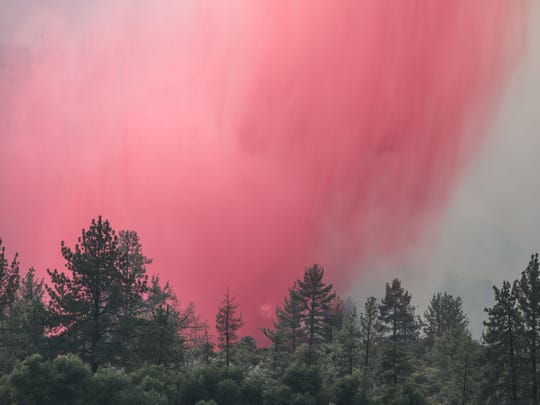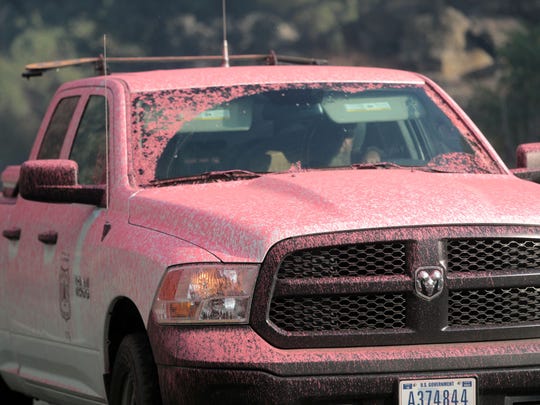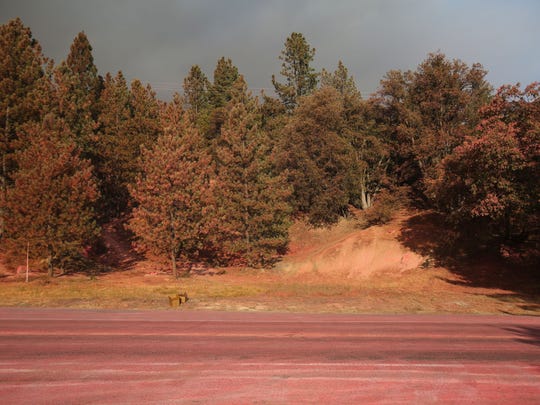That red fire retardant being used in California wildfires, like the Holy fire, won’t hurt you. Here’s what’s in it
Forrest Gordon Clark, the man accused of starting the Holy Fir, appeared in court for the first time Friday morning in Santa Ana. Palm Springs Desert Sun
Firefighters gained more control of the Holy Fire now burning in the Cleveland National Forest in Riverside County.
Forest officials said the fire has held steady, burning 22,986 acres by Wednesday morning. But firefighters have 72 percent of the fire’s perimeter contained. The agency’s damage-assessment team determined 12 single-family homes in Orange County and six in Riverside County were destroyed by the fire.
On Wednesday, 1,270 firefighters remained on hand, and forest officials said warming weather coupled with possible thunderstorms through the week are a concern. Still, officials expect the fire to be fully contained by Tuesday.
One reason for the daily successes in battling back the blaze is the red fire retardant captured in photos and videos as it is dropped on the flames and surrounding areas from jumbo jets following spotter planes.
That fire retardant can significantly slow the progress of a blaze and helps firefighters contain the spread and save property.
But it does make a mess for people returning home after fires, and many in fire zones have been left wondering what to do if it gets on their home or vehicle and how it might impact wildlife.
The U.S. Forest Service uses a product known by the brand name Phos-Chek, according to San Bernardino National Forest spokesman Zach Behrens. The retardant is manufactured by Missouri-based ICL Performance Products, which has been creating fire retardants to fight wildfires since the 1960s.*
The company’s website says its mixtures are the, “safest, most effective and environmentally friendly products available for fighting, managing and controlling wildland fires.”
According to safety sheets on the company website, the sticky mixture — which is combined with water before it is dropped over fire zones — is primarily composed of fertilizer, with a thickener and red dye added in. The dye ensures it is visible from the air, the thickener helps the slurry cling to trees, brush and other objects it is dropped on.
SIGN UP FOR FACEBOOK NEWS ALERTS: Message us here to get started
More: Holy Fire, now at 22,986 acres, is dropping ash. Here’s how to safely remove it from your property
More: In Idyllwild, the Fire District is the de facto local government.
 Buy PhotoFire retardant drop near Lake Hemet to fight the Cranston Fire on Thursday, July 26, 2018. (Photo: Richard Lui/The Desert Sun)
Buy PhotoFire retardant drop near Lake Hemet to fight the Cranston Fire on Thursday, July 26, 2018. (Photo: Richard Lui/The Desert Sun)
Cal Fire spokeswoman Heather Williams said the mixture is dropped strategically to protect homes or other structures and to help firefighters steer a fire off its current course and into an area where it can be fought more easily. As a blaze approaches an area where retardant has been dropped, a chemical reaction between the mixture and plants it has landed on occurs and makes it difficult for the fire to burn through that line.
“It basically acts as a fuel break to help slow down the fire,” she said. “It doesn’t put the fire out, but it really helps slow it down.”
Williams said pilots will survey a fire from the air and determine how best to utilize the retardant along with other natural fire breaks, including highways, mountain ridges and rivers.
The U.S. Department of Agriculture, which oversees the forest service, conducted an environmental review into the impact of fire retardant in 2011 after a judge ruled in favor of Citizens for Better Forestry, which had sued the USDA and asked the forest service to review its method of applying fire retardant and how it affects the environment.
 Buy PhotoA forest service truck is stained with fire retardant on Thursday, July 26, 2018 during the Cranston Fire. (Photo: Richard Lui/The Desert Sun)
Buy PhotoA forest service truck is stained with fire retardant on Thursday, July 26, 2018 during the Cranston Fire. (Photo: Richard Lui/The Desert Sun)
The report indicated that in rare cases the retardant can have a negative impact on water quality and aquatic species, so it is not supposed to be dropped within 300 feet of a waterway. The substance still comes into contact with water sources accidentally, but the USDA said the impact on those animals would be “minor and short term.” The same goes for water quality.
“Generally, impacts are short-term, as dilution occurs when the affected water moves downstream,” according to the report. However, in stagnant bodies of water, the fertilizers in the retardant can cause an overgrowth of plants.
More: Fire-stricken Idyllwild community, united by Jazz in the Pines, now must tell it good-bye
The impact of the nontoxic substance on human health is also “minimal.” Some people have reported skin irritation, according to the USDA, but generally the safety benefits of using the retardant outweighs those few incidents.
“On every fire, firefighter safety and public safety are the highest priorities. Aerially applied fire retardant reduces wildfire intensity and rate of spread, decreasing risks to firefighters and enabling them to construct fireline safely. In many situations, the use of retardant in concert with firefighters on the ground allows the Forest Service to safely meet its responsibilities to protect landscapes, resources, and people,” according to the USDA.
 Buy PhotoA section of HWY 243 is stained with fire retardant on Thursday, July 26, 2018 during the Cranston Fire. (Photo: Richard Lui/The Desert Sun)
Buy PhotoA section of HWY 243 is stained with fire retardant on Thursday, July 26, 2018 during the Cranston Fire. (Photo: Richard Lui/The Desert Sun)
The company that manufactures the retardant recommends washing with soap and water if you come in contact with the substance and to flush your eyes with water if it gets in your eyes. And while the substance is nontoxic, it shouldn’t be ingested by people or animals.
The company said emergency measures would not be necessary, but to contact a physician or veterinarian if the retardant is ingested by a person or pet. Cal Fire’s Williams said it was important for people with livestock to wash out any food and water basins for their animals if they were in areas where retardant was used.
Williams also advised people to wash the retardant off their homes or cars, rather than waiting for rain to do that. She said the mixture is easy to wash off if it’s relatively fresh. If it has hardened, people might need to use a power washer or some elbow grease.
